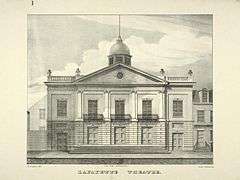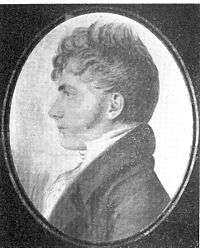Lafayette Circus (Manhattan)

Lafayette Circus Theatre emerged in Manhattan in 1825 as an equestrian circus arena; in 1826–1827 it was rebuilt into a conventional theatre hall with an orchestra pit and advanced rigging.[1] It boasted equipment for both equestrian (Hippodrama) and aquatic drama.[2] The theatre was destroyed by fire in 1829.
Lafayette Circus (named after the Marquis de Lafayette) was built on the corner of Laurens (now West Broadway) and Grand Street by Charles W. Sandford. He led an eccentric life from 1796- 1878 as one of New York’s favorite socialites. As a great lawyer he became a member of the New York Bar Association.[3] He was also a land developer and speculator. In 1822, Charles Sanford started buying up parcels of land on Canal and Laurens St. to create a new business center on the northern edge of the city. His plan was that if the block of buildings could be successfully rented out as offices, stores and residences, he could turn a handsome profit as their value increased. The added luxury of a circus would make the surrounding land even more valuable and increase the number of visitors to the district.[4] The newly erected theatre became the main attraction of a newly developed neighborhood.[5] On February 27, 1825 the first ever Hippodramatic show on American soil premiered at the Lafayette when last two acts of Richard III were staged with horses.[6] Hippodrama, part drama and part circus, the intended main event, was a recent invention that evolved from circus and horsemanship shows of the 18th century.[7] It emerged in England and France and quickly spread to the United States.[7] Lafayette Circus was the first American theatre specifically designed for hippodrama, followed by the Philadelphia Amphitheater and the Baltimore Roman Amphitheatre.[7]
The shows attracted lower classes, laborers and seamen,[8] "ready to riot at the slightest provocations";[9] "in fact, much of recorded rowdyism of the mid-1820s" took place at Lafayette Circus.[8] There were eleven recorded theatre riots in New York from 1825-1830, four of which occurred at the Lafayette.[10] Notable public disturbances and gang fights were recorded in December 1825 and in July 1826, when a watchman attempting to expel a prostitute barely escaped from the mob.[9][11]
Horse drama and other para-theatrical shows failed;[1] in 1826 the circus was sold and became the Lafayette Theatre, redesigned by Peter Grain, architect and theatrical designer. In October 1827 the New York Mirror described the building as "the largest and most splendid ever erected for theatrical purposes in the United States. The stage with its scenery and machinery exceed all former attempts in this country".[1] Nearly 100 feet wide and 120 feet deep, the stage was greater than anything existing in the United States or the United Kingdom.[1] The audience held no gallery seating, only box seating and a raised rake pit. The interior is described as having of spacious, windowed lobbies with an elegant domed interior house that was well ventilated and included a gas chandelier.[12] Stage lighting was described as "more natural"; a new lighting layout eliminated stage lamp ladders and allowed opening the whole width of the stage to the spectators.[1]
See also
References
- 1 2 3 4 5 Whitham, p. 126
- ↑ Banham, p. 1136
- ↑ Montilla p. 105
- ↑ <Montilla p. 106
- ↑ New York Mirror (October 1827), cited by Whitham, p. 126: "a section of the city which has sprung into existence, and arrived at maturity in so short a period..."
- ↑ (Odell p. 214)
- 1 2 3 McArthur, p. 21
- 1 2 Gilje, p. 252
- 1 2 Gilje, p. 251
- ↑ Gilje, Paul A. (1987-01-01). The Road to Mobocracy: Popular Disorder in New York City, 1763-1834. UNC Press Books. p. 249. ISBN 9780807841983.
- ↑ Bank, p. 52, noted that Lafayette Circus shared its block with brothels tending to the same clientele
- ↑ Odell, George C.D. (1928). Annals of the New York Stage. Columbia University Press. p. 343.
Sources
- Banham, Martin (1995). Cambridge Guide to Theatre. Cambridge University Press.
- Bank, Rosemary (1997). Theatre Culture in America, 1825-1860. Cambridge University Press. ISBN 0521563879, ISBN 978-0-521-56387-1.
- Gilje, Paul A. (1987). The road to mobocracy: popular disorder in New York City, 1763-1834. UNC Press. ISBN 0807841986, ISBN 978-0-8078-4198-3.
- McArthur, Benjamin (2007). The man who was Rip van Winkle: Joseph Jefferson and nineteenth-century American theatre. Yale University Press. ISBN 0300122322, ISBN 978-0-300-12232-9.
- Montilla, Robert Barry (1974). The History of the Lafayette Theatre. 1825-29. Print.
- Odell, George (1928). Annals of the New York Stage. Columbia New York. Columbia University Press. Print.
- Witham, Barry (1996). Theatre in the United States: 1750-1915, theatre in the colonies and United States. Cambridge University Press. ISBN 0521308585, ISBN 978-0-521-30858-8.
